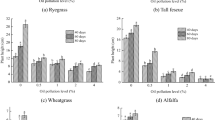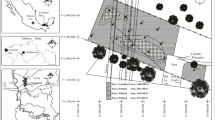Abstract
The aim of this research was to evaluate the potential of six legumes: Medicago sativa L., Glycine max, Arachis hypogea, Lablab purpureus, Pheseolus vulgaris and Cajanus cajan to restore within a short period of time soil contaminated with 3% crude oil. The legumes in five replications were grown in crude oil-contaminated and crude oil-uncontaminated soil in a completely randomized design. Plants were assessed for seedling emergence, plant height and leaf number. GC–MS was used to analyze the residual crude oil from the rhizosphere of the legumes. Plant growth parameters were reduced significantly (P < 0.05) for legumes in contaminated soil compared to their controls. In the 4th week after planting (WAP), shoot height increased across the species up to the 8th WAP. However, in the 12 WAP no significant increase in the shoot of all species was observed. Two WAP legumes planted in contaminated soil had significantly (P < 0.05) higher leaf number than these planted in uncontaminated soil with the exception of M. sativa. In the 4th WAP, only A. hypogea and P. vulgaris had increased leaf number, while in the 6th WAP, only L. purpureus had increased leaf number and survived up to the 12th WAP while most of the legumes species died. Chromatographic profiles indicated 100% degradation of the oil fractions in C. cajan and L. purpureus after 90 days. For other legumes however, greater losses of crude oil fractions C1–C10 and C10–C20 were indicated in rhizosphere soil of P. vulgaris and G. max, respectively. The most effective removal (93.66%) of C21–C30 components was observed in G. max-planted soil even though vegetation was not established. The legumes especially C. cajan, L. purpureus and A. hypogea are promising candidates for phytoremediation of petroleum hydrocarbon-impacted soil.

Similar content being viewed by others
References
Adam G, Duncan H (1999) Influence of diesel fuel on seed germination. Environ Pollut 10:363–370
Alkhatib MF, Alam Z, Muyibi SA, Hussain AF (2011) An isolated bacterial consortium for crude oil biodegradation. Afr J Biotechnol. doi:10.5897/AJB11.2749
Aprill W, Sims RC (1990) Evaluation of the use of prairie grasses for stimulating polycyclic aromatic hydrocarbon treatment in soil. Chemosphere 20:253–265
Ayotamuno JM, Kogbara RB (2007) Determining the tolerance level of zea mays (maize) to a crude oil polluted agricultural soil. Afr J Biotechnol 6(11):1332–1337
Baker JM (1970) The effects of oils on plants. Environ Pollut 1:27–44
Black CA, Evans DD, Esminger LE, Whils JZ, Clerk FE, Dinaver RC (1979) Method of soil analysis, part 2, chemical and microbiological properties. American Society for Agronomy Inc, Madison, pp 1142–1753
Chaineau CH, Morel JL, Oudot J (1997) Phytotoxicity and plant uptake of fuel oil hydrocarbons. J Environ Qual 26:1478–1483
Chaudhry Q, Blom-Zandstra M, Gupta S, Joner EJ (2005) Utilising the synergy between plants and rhizosphere microorganisms to enhance breakdown of organic pollutants in the environment. Environ Sci Pollut Res 12:34–48
Chauhan YS (1987) Screening for tolerance to salinity and waterlogging: case studies with pigeon pea and chickpea In: Adaptation of chickpea and pigeon pea to abiotic stresses. In: Proceedings of consultants’ work 19–21 December1984, ICRISAT India
Cunningham SD, Anderson TA, Schwab AP, Hsu FC (1996) Phytoremediation of soils contaminated with organic pollutants. Adv Agron 56:55–114
Das N, Chandra P (2011) Microbial degradation of petroleum hydrocarbon contaminants: an overview. Biotechnol Res Int. doi:10.4061/2011/941810
Diab EA (2008) Phytoremediation of oil contaminated desert soil using the rhizosphere effects. Global J Environ Res 2(2):66–73
Dominguez-Rosado E, Pichtel J (2004) Phytoremediation of soil contaminated with used motor oil: II Green-house studies. Environ Eng Sci 21(2):169–180
Farias V, Maranho LT, de Vasconcelos EC, da Silva Carvalho Filho MA, Lacerda LG, Azevedo JAM, Pandey A, Soccol CR (2009) Phytodegradation potential of Erythrina crista-galli L., Fabaceae, in petroleum contaminated soil. Appl Biochem Biotechnol 157:10–22
Frick CM, Farrell RE, Germida JJ (1999) Assessment of phytoremediation as an in situ technique for cleaning oil contaminated site: petroleum technology Alliance of Canada. http://www.rtdf.org/public/phyto/phylinks.htm
Gao Y, Zhu L (2003) Phytoremediation and its models for organic contaminated soils. J Environ Sci 15(3):302–310
Gaskin SE (2008) Rhizoremediation of hydrocarbon contaminated soil using Australian native grasses. Ph.D thesis Flinders University of South Australia, Australia
Greene JC, Bartels CL, Warren-Hicks WJ, Parkhurst BR, Linder GL, Peterson SA, Miller WE (1988) Protocols for short term toxicity screening of hazardous waste sites, EPA/600/3-88/029
Gunther T, Dornberger U, Fritsche W (1996) Effects of ryegrass on biodegradation of hydrocarbons in soil. Chemosphere 33(2):203–215
Hall J, Soole K, Bentham R (2011) Hydrocarbon phytoremediation in the family Fabacea—a review. Int J Phytoremed 13(4):317–332
Hulugalle NR, Lal R (1986) Root growth of maize in a compacted gravelly tropical alfisol as affected by rotation with a woody perennial. Field Crops Res 13:33–44
Ibrahim ML, Ijah UJJ (2014) Biodegradation of crude oil by rhizosphere microorganisms. Adv Environ Res 35:153–172
Ismail HY, Ijah UJJ, Riskuwa ML, Allamin IA, Isa MA (2014a) Assessment of Phytoremediation potential of legumes in spent engine oil contaminated soil. Eur J Environ Safety Sci 2(2):59–64
Ismail HY, Ijah UJJ, Riskuwa ML, Allamin II (2014b) Biodegradation of spent engine oil by bacteria isolated from the rhizosphere of legumes grown in contaminated soil. Int J Environ 3(2):63–75
Janik LT, Skjemstad JO, Shepherd KD, Spouncer LR (2007) The prediction of soil carbon fractions using mid-infrared-partial least square analysis. Aust J Soil Res 45:73–81
Kirk JL, Klironomos JN, Lee H, Trevors JT (2002) Phytotoxicity assay to assess plant species for phytoremediation of petroleum contaminated soil. Bioremed J 6(1):57–63
Knoke KL, Marwood TM, Cassidy MB, Liu D, Seech AG, Lee H, Trevors JT (1999) A comparison of five bioassays to monitor toxicity during bioremediation of pentachlorophenol-contaminated soil. Water 55. Air Soil Pollut 110:157–169
Lee SH, Lee WS, Lee CH, Km JG (2008) Degradation of phenanthrene and pyrene in rhizosphere of grasses and legumes. J Hazard Mat 153:892–898
Leigh GJ (2002) Nitrogen fixation at the Millenium. Elsevier Science, London
Li X, Feng Y, Sawatsky N (1997) Importance of soil water relations in assessing the endpoint of bioremediated soils. Plant Soil 192:219–226
Marques M, Rosa GS, Aguiar CRC, Correia SM, Carvalho EM (2010) Seedling emergence and biomass growth of oleaginous and other tropical species in oil contaminated soil. Waste Manag J 3(26–32):1
Marschner H (1995) Mineral nutrition of higher plants. Academic Press, London
Martin BC, George SJ, Price CA, Ryan MH, Tibbett M (2014) The role of root exuded low molecular weight organic anions in facilitating petroleum hydrocarbon degradation: current knowledge and future directions. Sci Total Environ 472:642–653
Masakorala K, Yao J, Chandankere R, Yuan H, Liu H, Yu C, Cai M (2013) Effects of petroleum hydrocarbon contaminated soil on germination, metabolism and early growth of green gram, Vigna radiata L. Bull Environ Contam Toxicol 91(2):224–230
Medina-Bellver JI, Marin P, Delgado A, Rodriguez Sanchez A, Reyes E, Ramos JL, Marque S (2005) Evidence for in situ crude oil biodegradation after the prestige oil spill. Environ Microbiol 7(6):773–779
Merkl N, Schultze-Kraft R, Infante C (2004) Assessment of tropical grasses and legumes for phytoremediation of petroleum contaminated soils. Water Air Soil Pollut 165:195–209
Muratova AY, Hubner T, Narula N, Wand H et al (2003) Rhizosphere microflora of plants used for the phytoremediation of bitumen–contaminated soil. Microbiol Res 158:151–161
Muratova AY, Dmitrieva TV, Panchenko LV, Turkovskaya OV (2008) Phytoremediation of oil-sludge—contaminated soil. Int J Phytorem 10:486–502
Nichols TD, Wolf DC, Rogers HB, Beyrouty CA, Reynolds CM (1997) Rhizosphere microbial populations in contaminated soils. Water Air Soil Pollut 95(1–4):165–178
Njoku KL, Akinola MO, Oboh BO (2009) Phytoremediation of crude oil contaminated soil. The effect of growth of Glycine max on the physicochemistry and crude oil contents oil. Nat Sci 7(10):79–87
Nwoko CO, Okeke PN, Agwu OO, Akpan IE (2007) Performance of Pheseolus vulgaris L. in a soil contaminated with spent engine oil. Afric. J Biotechnol 6(16):1922–1925
Olson PE, Castro A, Joem M, Du Teau NM (2007) Comparison of plant families in a greenhouse phytoremediation study on aged polycyclic aromatic hydrocarbon-contaminated soil. J Environ Qual 36(5):1461–1469
Pagé AP, Yergeau É, Greer CW (2015) Salix purpurea stimulates the expression of specific bacterial xenobiotic degradation genes in a soil contaminated with hydrocarbons. PLoS ONE 10(7):e0132062. doi:10.1371/journal.pone.0132062
Palmroth MRT, Pichtel J, Puhakka JA (2002) Phytoremediation of subarctic soil contaminated with diesel fuel. Bioresour Technol 84:221–228
Phillips LA (2008) The relationship between plants and their root-associated microbial communities In Hydrocarbon phytoremediation systems. Ph.D Thesis, University of Saskatchewan Saskatoon, USA
Rentz JA, Alvarez PJJ, Schnoor JL (2004) Repression of Pseudomonas putida phenanthrene-degrading activity by plant root extracts and exudates. Environ Microbiol 6:574–583
Robson DB, Germida JJ, Farell RE, Knight JD (2004) Hydrocarbon tolerance correlates with seed mass and relative growth rate. Bioremediat J 8(3–4):185–199
Schnoor JL (1997) Phytoremediation. In: 09GWRTAC Series-Technology evaluation report, TE- 98–01. Ground Water Remediation Technology Analysis Center, Pittsburgh (PA), pp 5–10
Semple KT, Morriss AWJ, Paton GI (2003) Bioavailability of hydrophobic organic contaminants in soils: fundamental concepts and techniques for analysis. Eur J Soil Sci 54(4):809–818
Sharifi M, Sadeghi Y, Akbarpour M (2007) Germination and growth of six plant species on contaminated soil with spent oil. Int J Environ Sci Technol 4(4):463–470
Sharma P, Pandey S (2014) Status of phytoremediation in world scenario. Int J Environ Bioremed Biodegrad 2(4):178–191
Singer AC, Crowley DE, Thompson IP (2003) Secondary plant metabolites in phytoremediation and biotransformation. Trends Biotechnol 21(3):123–130
Smith MJ, Flowers TA, Duncan HJ, Adler J (2006) Effect of polycyclic aromatic hydrocarbons on germination and subsequent growth of grasses and legumes in freshly contaminated soil and soil 41 with aged PAHs residues. Environ Pollut 141:519–525
Somtrakoon K, Chouychai W, Lee H (2014) Comparing anthracene and fluorine degradation in anthracene 44 and fluorine-contaminated soil by single and mixed plant cultivation. Int J Phytorem 16:415–428
Spaires JD, Kenworthy KE, Rhykerd RL (2001) Root and shoot biomass of plants seeded in crude oil contaminated soil. Texas J Agric Nat Resour 14:117–124
Stephen E, Ijah UJJ (2011) Comparison of Glycine max and Sida acuta in the phytoremediation of waste lubricating oil polluted soil. Nat Sci 9(8):190–193
Vwioko DE, Fashemi DS (2005) Growth response of Ricinus comminus L. (castor oil) in spent lubricating oil polluted soil. J Appl Sci Environ Manag 9(2):73–79
White PL Jr, Wolf DC, Thoma GJ, Reynolds CM (2006) Phytoremediation of alkylated polycyclic aromatic hydrocarbons in a crude oil-contaminated soil. Water Air Soil Pollut 169:207–211
Wiltse CC, Rooney WL, Chen Z, Schwab AP, Banks MK (1998) Greenhouse evaluation of agronomic and crude oil phytoremediation potential among alfalfa genotypes. J Environ Qual 27:169–173
Acknowledgement
The authors gratefully acknowledge the financial support from Tertiary Education Trust Fund (TetFund) Petroleum Technology Development Fund (PTDF) and Usmanu Danfodiyo University Sokoto. We would also like to acknowledge KRPC and NAPRI for providing crude oil and plant seeds, respectively. The authors declare that they do not have conflict of interest.
Author information
Authors and Affiliations
Corresponding author
Additional information
Editorial responsibility: Sivakumar Durairaj.
Electronic supplementary material
Below is the link to the electronic supplementary material.
Rights and permissions
About this article
Cite this article
Riskuwa-Shehu, M.L., Ijah, U.J.J., Manga, S.B. et al. Evaluation of the use of legumes for biodegradation of petroleum hydrocarbons in soil. Int. J. Environ. Sci. Technol. 14, 2205–2214 (2017). https://doi.org/10.1007/s13762-017-1303-5
Received:
Revised:
Accepted:
Published:
Issue Date:
DOI: https://doi.org/10.1007/s13762-017-1303-5




